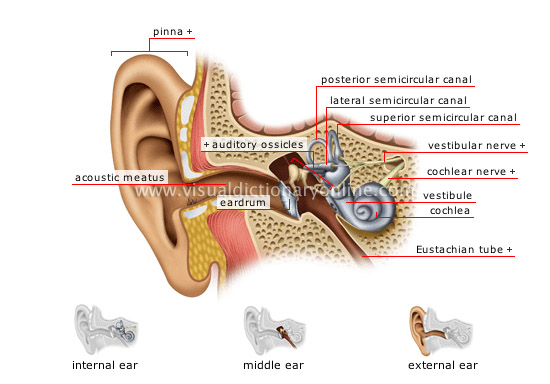structure of the ear
The ear is made up of three distinct parts; hearing is controlled by the inner ear, which contains the sensory organs.
eardrum 
Slender resistant elastic membrane; it vibrates when sound waves are received from the auditory canal, then transmits the waves to the ossicles.
Eustachian tube 
Tube connecting the middle ear to the nasopharynx; it allows outside air to pass through, thus equalizing air pressure on both sides of the eardrum.
vestibule 
Bony structure into which the three semicircular canals open; with these canals, it is responsible for equilibrium.
cochlea 
Bony structure intended for hearing; it receives vibrations from the ossicles and transforms them into nervous impulses before transmitting them to the brain.
lateral semicircular canal 
Horizontal canal; it monitors head movements to ensure that equilibrium is maintained.
cochlear nerve 
Nerve transmitting auditory messages collected in the cochlea to the brain. The cochlear and vestibular nerves join to form the auditory nerve.
vestibular nerve 
Nerve transmitting messages related to equilibrium to the brain; it emanates from the vestibule and the semicircular canals.
superior semicircular canal 
Vertical canal perpendicular to the temporal bone; it monitors head movements to ensure that equilibrium is maintained.
auditory ossicles 
The smallest bones in the human body, held in place by several muscles and ligaments; they amplify the vibrations of the eardrum.
posterior semicircular canal 
Vertical canal parallel to the temporal bone; it monitors head movements to ensure that equilibrium is maintained.
pinna 
Soft cartilaginous outer portion of the ear located at the side of the head; it allows sounds to be collected.
acoustic meatus 
Canal carrying the sounds collected by the pinna to the eardrum. It is lined with hair and covered with cerumen, a waxy substance that retains dust particles.
internal ear 
Liquid-filled cavity hollowed out of the temporal bone that transforms sound vibrations into nerve influxes to be interpreted by the brain.
middle ear 
Air-filled cavity hollowed out of the temporal bone; it receives sounds from the external ear, amplifies them through the auricles and transmits them to the internal ear.
external ear 
Visible portion of the ear enabling sounds to be collected and directed to the middle ear through the acoustic meatus.

















